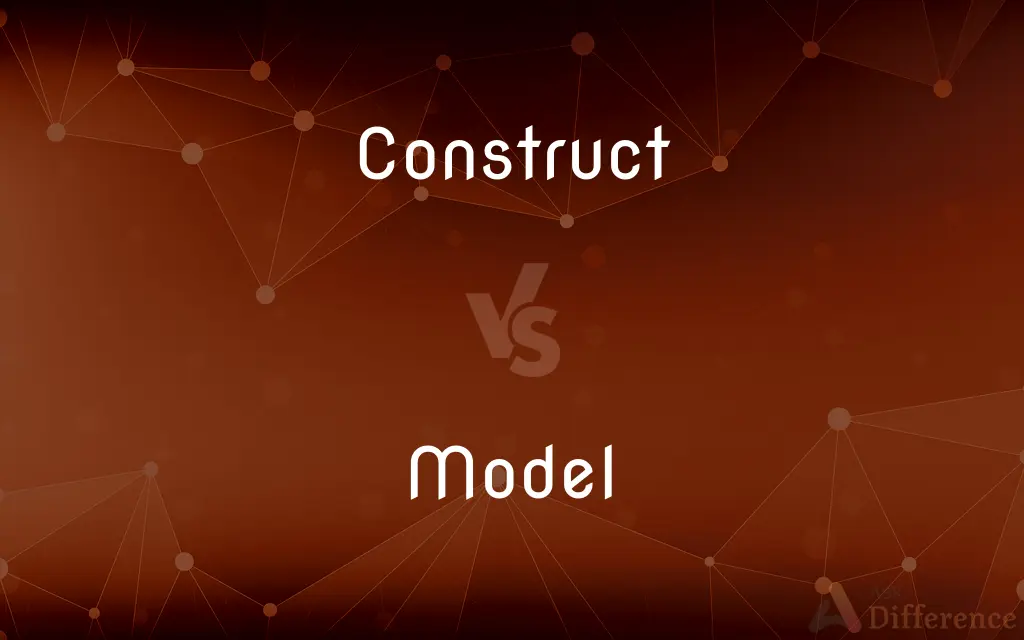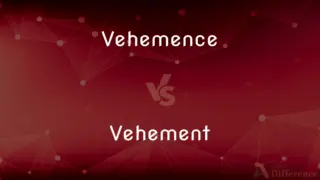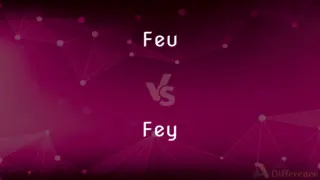Construct vs. Model — What's the Difference?
By Fiza Rafique & Urooj Arif — Updated on April 17, 2024
Construct refers to an abstract idea formed from various elements, used mainly in social sciences; a model is a representation or simulation used to explain or predict real-world behaviors.

Difference Between Construct and Model
Table of Contents
ADVERTISEMENT
Key Differences
A construct is an abstract concept developed to understand various psychological or sociological phenomena, such as intelligence or socioeconomic status. On the other hand, a model can refer to both physical and theoretical representations used to simulate, represent, or understand an aspect of the real world, such as a scale model of a building or a mathematical model of climate change.
Constructs are typically used in theoretical frameworks to help explain relationships between different variables. Whereas models are often employed in both scientific and engineering disciplines to test hypotheses, predict outcomes, or visualize complex systems.
The development of a construct involves identifying and defining specific elements that make up a broader concept, often without a physical form. In contrast, models are usually tangible or visually representable and can be directly manipulated or altered to observe different outcomes.
In research, constructs require operational definitions that specify how they are measured or identified in different contexts. On the other hand, models may require calibration or validation against real-world data to ensure their accuracy and applicability.
Constructs play a crucial role in the development of instruments and measurement scales that are used to assess abstract qualities. Models, however, are critical in experiments and simulations where theoretical concepts need to be tested under controlled or simulated environments.
ADVERTISEMENT
Comparison Chart
Definition
An abstract concept used to understand phenomena.
A representation used to simulate or predict reality.
Usage
Mainly in social sciences.
Across various scientific, educational, and industrial fields.
Physical Form
Typically non-physical, theoretical.
Often physical (e.g., prototypes) or visual (e.g., diagrams).
Purpose
To define and frame theoretical frameworks.
To test hypotheses, predict outcomes, or visualize systems.
Example of Creation
Developing a construct for "resilience" based on psychological traits.
Creating a 3D model of a building to study architectural designs.
Compare with Definitions
Construct
A theoretical concept formed from specific elements to explain or study behaviors and phenomena.
Intelligence is a construct used in psychology to understand cognitive abilities.
Model
A physical or mathematical representation used in scientific research.
Animal models in biomedical research help understand disease mechanisms.
Construct
A complex idea or theory often used in social sciences.
Socioeconomic status is a construct that encompasses income, education, and occupation.
Model
A scaled or full-size representation of something used as a tool to teach or explain.
The classroom globe is a model of the Earth used for educational purposes.
Construct
A non-tangible framework used to assemble other related concepts.
Personality types are constructs that help categorize different human behaviors.
Model
A simplified version of a system that represents its functioning or structure.
Computer models are used to predict weather patterns.
Construct
An abstract entity developed to facilitate understanding of specific attributes.
The construct of job satisfaction is crucial in organizational behavior studies.
Model
An ideal example that serves as a basis for imitation or comparison.
Role models play a significant part in shaping young people’s values.
Construct
A conceptual tool used to measure or assess intangible qualities.
Constructs like self-esteem are measured using various psychological scales.
Model
A theoretical framework developed to solve specific problems or predict outcomes.
Economic models help forecast market trends based on current data.
Construct
To form by assembling or combining parts; build.
Model
A small object, usually built to scale, that represents in detail another, often larger object.
Construct
To create (an argument or a sentence, for example) by systematically arranging ideas or terms.
Model
A preliminary work or construction that serves as a plan from which a final product is to be made
A clay model ready for casting.
Construct
(Mathematics) To draw (a geometric figure) that meets specific requirements.
Model
Such a work or construction used in testing or perfecting a final product
A test model of a solar-powered vehicle.
Construct
Something formed or constructed from parts.
Model
A schematic description or representation of something, especially a system or phenomenon, that accounts for its properties and is used to study its characteristics
A model of generative grammar.
A model of an atom.
An economic model.
Construct
A concept, model, or schematic idea
A theoretical construct of the atom.
Model
A style or design of an item
My car is last year's model.
Construct
A concrete image or idea
"[He] began to shift focus from the haunted constructs of terror in his early work" (Stephen Koch).
Model
One serving as an example to be imitated or compared
A model of decorum.
Construct
Something constructed from parts.
The artwork was a construct of wire and tubes.
Loops and conditional statements are constructs in computer programming.
Model
One that serves as the subject for an artist, especially a person employed to pose for a painter, sculptor, or photographer.
Construct
A concept or model.
Bohr's theoretical construct of the atom was soon superseded by quantum mechanics.
Model
One that serves as the basis for a fictional character or place.
Construct
(genetics) A segment of nucleic acid, created artificially, for transplantation into a target cell or tissue.
Model
A person employed to display merchandise, such as clothing or cosmetics.
Construct
(transitive) To build or form (something) by assembling parts.
We constructed the radio from spares.
A wall constructed of random stones.
Model
(Zoology) An animal whose appearance is copied by a mimic.
Construct
(transitive) To build (a sentence, an argument, etc.) by arranging words or ideas.
A sentence may be constructed with a subject, verb and object.
Model
Being, serving as, or used as a model.
Construct
To draw (a geometric figure) by following precise specifications and using geometric tools and techniques.
Construct a circle that touches each vertex of the given triangle.
Model
Worthy of imitation
A model child.
Construct
To put together the constituent parts of (something) in their proper place and order; to build; to form; to make; as, to construct an edifice.
Model
To make or construct a descriptive or representational model of
Computer programs that model climate change.
Construct
To devise; to invent; to set in order; to arrange; as, to construct a theory of ethics.
Model
To plan, construct, or fashion in imitation of a model
Modeled his legal career after that of his mentor.
Construct
Formed by, or relating to, construction, interpretation, or inference.
Model
To make by shaping a plastic substance
Modeled a bust from clay.
Construct
An abstract or general idea inferred or derived from specific instances
Model
To form (clay, for example) into a shape.
Construct
Make by combining materials and parts;
This little pig made his house out of straw
Some eccentric constructed an electric brassiere warmer
Model
To display by wearing or posing in
Model clothes.
Construct
Put together out of components or parts;
The company fabricates plastic chairs
They manufacture small toys
Model
In painting, drawing, and photography, to give a three-dimensional appearance to, as by shading or highlighting.
Construct
Draw with suitable instruments and under specified conditions;
Construct an equilateral triangle
Model
To exhibit (a behavior) in such a way as to promote the establishment of similar patterns of behavior in another
The therapist modeled socially appropriate conversation.
Construct
Create by linking linguistic units;
Construct a sentence
Construct a paragraph
Model
To repeat (a behavior observed in another)
The child was modeling her mother's nurturing behavior.
Construct
Create by organizing and linking ideas, arguments, or concepts;
Construct a proof
Construct an argument
Model
To make a model.
Construct
Reassemble mentally;
Reconstruct the events of 20 years ago
Model
To work or serve as a model, as in wearing clothes for display or serving as the subject of an artist.
Model
A person who serves as a subject for artwork or fashion, usually in the medium of photography but also for painting or drawing.
The beautiful model had her face on the cover of almost every fashion magazine imaginable.
Model
A person, usually an attractive male or female that is hired to show items or goods to the public, such as items that are given away as prizes on a TV game show.
Model
A representation of a physical object, usually in miniature.
The boy played with a model of a World War II fighter plane.
Model
A simplified representation used to explain the workings of a real world system or event.
The computer weather model did not correctly predict the path of the hurricane.
Model
A style, type, or design.
He decided to buy the turbo engine model of the sports car.
This year's model features four doors instead of two.
Model
The structural design of a complex system.
The team developed a sound business model.
Model
A successful example to be copied, with or without modifications.
He was a model of eloquence and virtue.
British parliamentary democracy was seen as a model for other countries to follow.
Model
(logic) An interpretation function which assigns a truth value to each atomic proposition.
Model
(logic) An interpretation which makes a set of sentences true, in which case that interpretation is called a model of that set.
Model
(medicine) An animal that is used to study a human disease or pathology.
Model
Any copy, or resemblance, more or less exact.
Model
(software architecture) In software applications using the model-view-controller design pattern, the part or parts of the application that manage the data.
Model
Worthy of being a model; exemplary.
Model
(transitive) to display for others to see, especially in regard to wearing clothing while performing the role of a fashion model
She modelled the shoes for her friends to see.
Model
(transitive) to use as an object in the creation of a forecast or model
They modelled the data with a computer to analyze the experiment’s results.
Model
(transitive) to make a miniature model of
He takes great pride in his skill at modeling airplanes.
Model
(transitive) to create from a substance such as clay
The sculptor modelled the clay into the form of a dolphin.
Model
(intransitive) to make a model or models
Model
(intransitive) to work as a model in art or fashion
The actress used to model before being discovered by Hollywood.
Model
A miniature representation of a thing, with the several parts in due proportion; sometimes, a facsimile of the same size; as, a
In charts, in maps, and eke in models made.
I had my father's signet in my purse,Which was the model of that Danish seal.
You have the models of several ancient temples, though the temples and the gods are perished.
Model
Something intended to serve, or that may serve, as a pattern of something to be made; a material representation or embodiment of an ideal; sometimes, a drawing; a plan; as, the clay model of a sculpture; the inventor's model of a machine.
[The application for a patent] must be accompanied by a full description of the invention, with drawings and a model where the case admits of it.
When we mean to buildWe first survey the plot, then draw the model.
Model
Anything which serves, or may serve, as an example for imitation; as, a government formed on the model of the American constitution; a model of eloquence, virtue, or behavior.
Model
That by which a thing is to be measured; standard.
He that despairs measures Providence by his own little, contracted model.
Model
Any copy, or resemblance, more or less exact.
Thou seest thy wretched brother die,Who was the model of thy father's life.
Model
A person who poses as a pattern for an artist; as, the artist used his daughter as a model for an Indian maiden.
Model
A person who is employed to wear clothing for the purpose of advertising or display, or who poses with a product for the same purpose; a mannequin{1}; as, a fashion model.
A professional model.
Model
A particular version or design of an object that is made in multiple versions; as, the 1993 model of the Honda Accord; the latest model of the HP laserjet printer. For many manufactured products, the model name is encoded as part of the model number.
Model
An abstract and often simplified conceptual representation of the workings of a system of objects in the real world, which often includes mathematical or logical objects and relations representing the objects and relations in the real-world system, and constructed for the purpose of explaining the workings of the system or predicting its behavior under hypothetical conditions; as, the administration's model of the United States economy predicts budget surpluses for the next fifteen years; different models of the universe assume different values for the cosmological constant; models of proton structure have grown progressively more complex in the past century.
Model
Suitable to be taken as a model or pattern; as, a model house; a model husband.
Model
To plan or form after a pattern; to form in model; to form a model or pattern for; to shape; to mold; to fashion; as, to model a house or a government; to model an edifice according to the plan delineated.
Model
To make a copy or a pattern; to design or imitate forms; as, to model in wax.
Model
A simplified description of a complex entity or process;
The computer program was based on a model of the circulatory and respiratory systems
Model
A type of product;
His car was an old model
Model
A person who poses for a photographer or painter or sculptor;
The president didn't have time to be a model so the artist worked from photos
Model
Representation of something (sometimes on a smaller scale)
Model
Something to be imitated;
An exemplar of success
A model of clarity
He is the very model of a modern major general
Model
Someone worthy of imitation;
Every child needs a role model
Model
A representative form or pattern;
I profited from his example
Model
A woman who wears clothes to display fashions;
She was too fat to be a mannequin
Model
The act of representing something (usually on a smaller scale)
Model
Plan or create according to a model or models
Model
Form in clay, wax, etc;
Model a head with clay
Model
Assume a posture as for artistic purposes;
We don't know the woman who posed for Leonardo so often
Model
Display (clothes) as a mannequin;
Model the latest fashion
Model
Create a representation or model of;
The pilots are trained in conditions simulating high-altitude flights
Model
Construct a model of;
Model an airplane
Model
Worthy of imitation;
Exemplary behavior
Model citizens
Common Curiosities
Can you give an example of a construct?
An example of a construct is 'intelligence', which encompasses various cognitive abilities and skills.
What are the uses of a model?
Models are used in various fields like science, engineering, and education to visualize, simulate, and predict phenomena.
What is a construct?
A construct is an abstract concept typically used in social sciences to understand and measure phenomena.
How is a model different from a construct?
A model is a representation or simulation, often physical, used to predict or explain real-world behaviors, whereas a construct is an abstract concept used to frame theoretical ideas.
How do constructs impact research?
Constructs help in forming hypotheses and frameworks that guide the collection and analysis of data in research studies.
How are constructs developed?
Constructs are developed through research and theoretical analysis, often involving the identification and definition of components that can be broadly applied to study specific phenomena.
Is a model always an accurate representation?
Models are simplifications and may not always fully represent the complexity of what they are simulating, often requiring adjustments and validations.
Are constructs always non-physical?
Yes, constructs are typically non-physical and theoretical, developed to describe or understand aspects of human behavior or social phenomena.
Can models be digital?
Yes, models can be digital, such as software simulations and computer-generated algorithms used in various research and practical applications.
What is the purpose of a model in science?
In science, models are used to test hypotheses, explore scenarios, and predict future occurrences based on current data.
Share Your Discovery

Previous Comparison
Vehemence vs. Vehement
Next Comparison
Feu vs. FeyAuthor Spotlight
Written by
Fiza RafiqueFiza Rafique is a skilled content writer at AskDifference.com, where she meticulously refines and enhances written pieces. Drawing from her vast editorial expertise, Fiza ensures clarity, accuracy, and precision in every article. Passionate about language, she continually seeks to elevate the quality of content for readers worldwide.
Co-written by
Urooj ArifUrooj is a skilled content writer at Ask Difference, known for her exceptional ability to simplify complex topics into engaging and informative content. With a passion for research and a flair for clear, concise writing, she consistently delivers articles that resonate with our diverse audience.















































